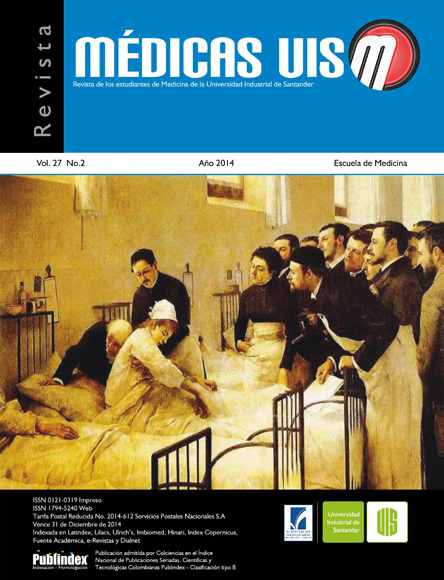Resumen
Con el aumento de la expectativa de vida, se está llegando a un incremento marcado de la patología geriátrica en los departamentos de urgencias; en el caso del delirium se ha demostrado en cerca del 14% de los ancianos hospitalizados y llegando a una incidencia variable entre el 10 al 52% en el grupo postquirúrgico de cadera. El delirium en los últimos 30 años ha presentado un interés marcado en la literatura médica como resultado del renacimiento como diagnostico en la unidades de urgencias y cuidados intensivos, seguramente como consecuencia de la aparición de especialidades médicas como la geriatría que han rescatado la patología del anciano; el presente artículo realiza una revisión del delirium en los departamentos de urgencias y su correlación con el envejecimiento de la población.
Referencias
2. McCaig LF, Burt CW. National Hospital Ambulatory Medical Care Survey: 2002 emergency department summary. Adv Data. 2004;(340):1–34.
3. Strange GR, Chen EH, Sanders AB. Use of emergency departments by elderly patients: projections from a multicenter data base. Ann Emerg Med. 1992;21(7):819–24.
4. Wofford JL, Schwartz E, Timerding BL, Folmar S, Ellis SD, Messick CH. Emergency department utilization by the elderly: analysis of the National Hospital Ambulatory Medical Care Survey. Acad Emerg Med. 1996;3(7):694–9.
5. Wilber ST, Gerson LW. A research agenda for geriatric emergency medicine. Acad Emerg Med. 2003;10(3):251–60.
6. Milbrandt EB, Deppen S, Harrison PL, Shintani AK, Speroff T, Stiles RA, et al. Costs associated with delirium in mechanically ventilated patients. Crit Care Med. 2004;32(4):955-62.
7. American Psychiatric Association. American Psychiatric Association. Task Force on DSM-IV. Diagnostic and statistical manual of mental disorders: DSM-IV. 4° ed. Washington, DC: American Psychiatric Association; 1994.
8. Meagher DJ, Trzepacz PT. Motoric subtypes of delirium. Semin Clin Neuropsychiatry. 2000;5(2):75–85.
9. Pandharipande P, Cotton BA, Shintani A, Thompson J, Costabile S, Truman PB, et al. Motoric subtypes of delirium in mechanically ventilated surgical and trauma intensive care unit patients. Intensive Care Med. 2007;33(10):1726–31.
10. Liptzin B, Levkoff SE. An empirical study of delirium subtypes. Br J Psychiatry. 1992;161:843–5.
11. Reyes C. El anciano con delirium: diagnóstico, evaluación y manejo. Rev. Asoc Colomb Gerontol Geriatr. 2001;15(2):245-51.
12. Inouye SK, Viscoli CM, Horwitz RI, Hurst LD, Tinetti ME. A predictive model for delirium in hospitalized elderly medical patients based on admission characteristics. Ann Intern Med. 1993;119(6):474–81.
13. Elie M, Cole MG, Primeau FJ, Bellavance F. Delirium risk factors in elderly hospitalized patients. J Gen Intern Med. 1998;13(3):204–12.
14. Rahkonen T, Makela H, Paanila S, Halonen P, Silvenius J, Sulkava R. Delirium in elderly people without severe predisposing disorders: etiology and 1-year prognosis after discharge. Int Psychogeriatr. 2000;12(4):473–81.
15. Kakuma R, du Fort GG, Arsenault L, Perrault A, Platt RW, Monette J, et al. Delirium in older emergency department patients discharged home: effect on survival. J Am Geriatr Soc. 2003;51(4):443–50.
16. Monette J, Galbaud G, Fung SH, Massoud F, Moride Y, Arsenault L, et al. Evaluation of the Confusion Assessment Method (CAM) as a screening tool for delirium in the emergency room. Gen Hosp Psychiatry. 2001;23(1):20–5.
17. Cerejeira, J, Firmino, H, Vaz-Serra, A, Mukactova-Ladinska, EB. The neuroinflammatory hypothesis of delirium. Act Neuropathol. 2010;119(6):737-54.
18. Hustey FM, Meldon SW. The prevalence and documentation of impaired mental status in elderly emergency department patients. Ann Emerg Med. 2002;39(3):248–53.
19. Hustey FM, Meldon S, Palmer R. Prevalence and documentation of impaired mental status in elderly emergency department patients. Acad Emerg Med. 2000;7(10):1166.
20. Hustey FM, Meldon SW, Smith MD, Lex CK. The effect of mental status screening on the care of elderly emergency department patients. Ann Emerg Med. 2003;41(5):678–84.
21. Lewis LM, Miller DK, Morley JE, Nork MJ, Lasater LC. Unrecognized delirium in ED geriatric patients. Am J Emerg Med. 1995;13(2):142–5.
22. Elie M, Rousseau F, Cole M, Primeau F, McCusker J, Bellavance F. Prevalence and detection of delirium in elderly emergency department patients. CMAJ. 2000;163(8):977–81.
23. Ross CA, Peyser CE, Shapiro I, Folstein MF. Delirium: phenomenologic and etiologic subtypes. Int Psychogeriatr. 1991;3(2):135–47.
24. American Psychiatric Association. Practice guideline for the treatment of patients with delirium. Am J Psychiatry. 1999;156(5 Suppl):1–20.
25. Hu H, Deng W, Yang H. A prospective random control study: comparison of olanzapine and haloperidol in senile delirium. Chongqing Med J. 2004;8:1234–7.
26. Vidan MT, Sanchez E, Alonso M, Montero B, Ortiz J, Serra JA. An intervention integrated into daily clinical practice reduces the incidence of delirium during hospitalization in elderly patients. J Am Geriatr Soc. 2009;57(11):2029-36.
27. Lee KU, Won WY, Lee HK, Kweon YS, Lee CT, Pae CU, et al. Amisulpride versus quetiapine for the treatment of delirium: a randomized, open prospective study. Int Clin Psychopharmacol. 2005;20(6):311–4.
28. Catalano G, Catalano MC, Alberts VA. Famotidine-associated delirium. A series of six cases. Psychosomatics. 1996;37(4):349–55.
29. Picotte-Prillmayer D, DiMaggio JR, Baile WF. H2 blocker delirium. Psychosomatics. 1995;36(1):74–7.
30. Pitkälä KH, Laurila JV, Strandberg TE, Tilvis RS. Multicomponent geriatric intervention for elderly inpatients with delirium: a randomized, controlled trial. J Gerontol A Biol Sci Med Sci. 2006;61(2):176–81.
